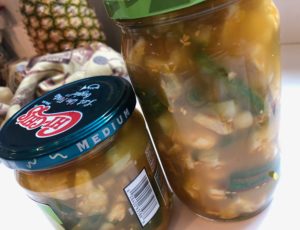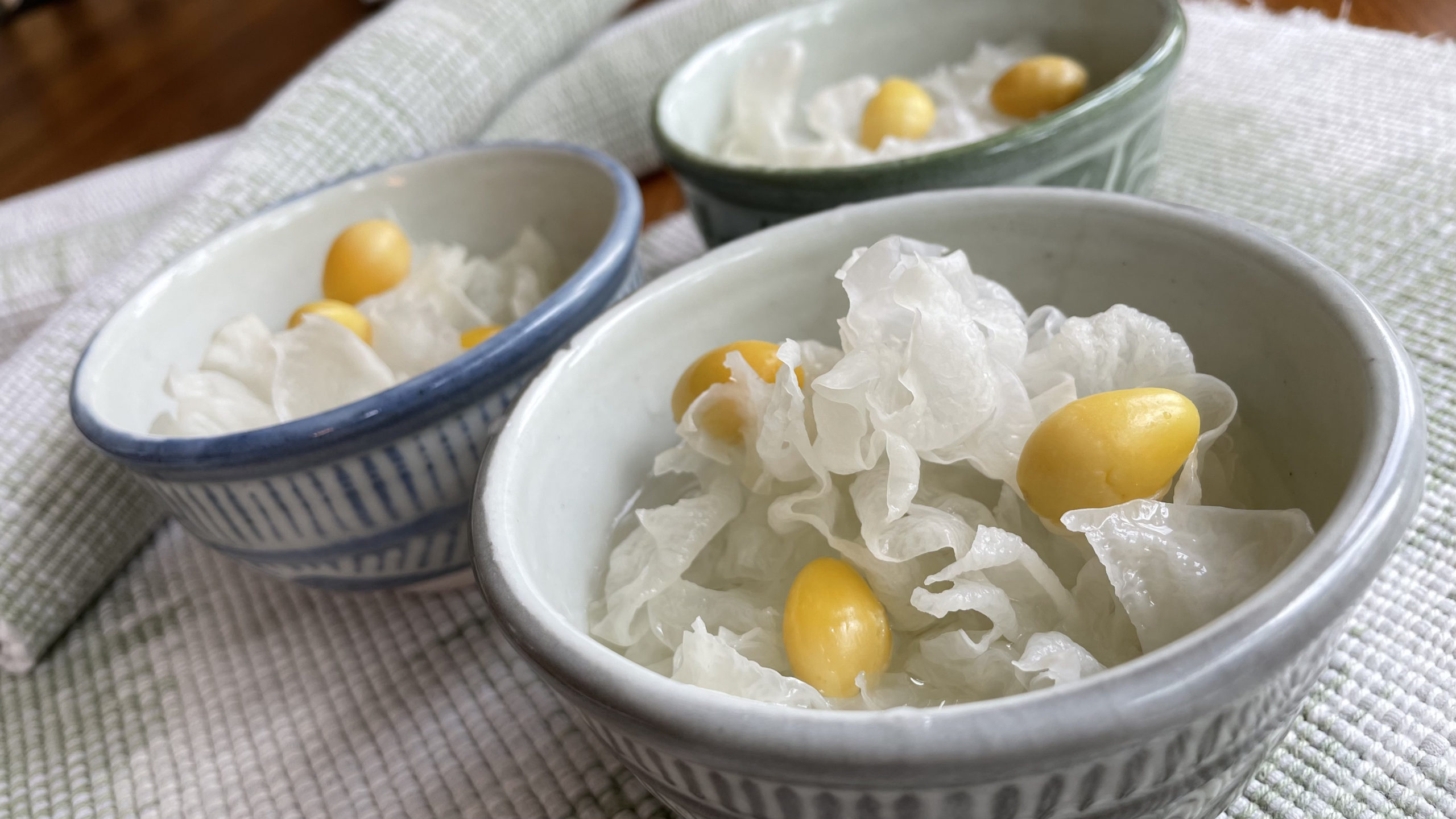I saw someone drizzle vinegar on cauliflower as a palette cleanser for a charcuterie board and I remembered one of our beloved pickle in Singapore which has cauliflower.
Achar — this is spicy pickle of a colorful selection of veggies, typically cucumber, carrot, chili, string bean, and cauliflower. I first ate it as a child when my piano teacher’s mother, a Nonya lady, gave us a jar.
Nonya describes women of Straits Chinese heritage. Their forefathers were the earliest migrants who came from China and settled in Malaya and Singapore. Men from the southern Chinese provinces came as traders, settled here, married Malay women and adopted their culture. Their community speak both Chinese and Malay, have a distinct style in dress and accessories, and created a wonderful blend of Malay and Chinese food.
Peranakans, as they are also known, are very proud of their food and culinary techniques and tradition has it that these were much sought after skills in a wife and daughter-in-law. A future mother-in-law need only listen to how a young woman pounds ingredients in a mortar with a pestle to determine if she is a good cook.
There are many types of Achar and this one is a simplified Nonya style…but please don’t judge me. I’m not Nonya, and I’d probably never pass the tumbuk test. (Tumbuk means pound in a mortar.) The proper way to make this is to pound the rempah, a blended ingredients of roots and aromatics.) Typically it includes garlic, shallots, ginger, galangal, candlenuts and chili.

If you think I’ve adulterated the Nonya Achar, blame my sister because she explained this to me over WhatsApp. In typical Asian fashion all she gave me was: 2 big spoonfuls of curry powder, shallots, garlic and a large knob of galangal. As I mentioned in my last post, we don’t measure in exact terms. She expected me to know better.
I was suspicious about her two heaped spoonfuls of curry powder and reduced it by half .
When I finally bottled it and WhatsApp her my result, she said: “Why the color so light? Look like angmoh achar!” Translation: “Your achar is very pale (probably not tasty) and looks like a foreigner made it.”
That’s typical Chinese big sister for you, not unlike the Asian “B is a failing grade…A is not good enough…Why didn’t you get an A+”? Light or not, it tasted good–the fragrance of the galangal really gave it a wonderful perfume. (I forgot to add ginger but don’t tell her.)
Of course she had to make it that same night and send me the “correct” color. Shown above, I must say it does look colorful. But it WILL be spicy.
Some notes: Cut veggies about the same size. Make sure you scrape off all the seeds of the cucumber.
The brining of the vegetables is important. Keep each vegetable in its own bag and add about ½ teaspoon salt before squeezing out the air and closing the bag. If you do this and leave the veggies overnight, it will be ready by the next day.
We want the vegetable brined. Not raw, not too limp but still crisp. Bend the vegetable to test proper crispness. If it snaps it’s not brined enough. Overnight brining works best. I’ve tried this making Pickled Green Chili.
After the rempah is fried, the vegetables is mixed in.
I decided to mix the sugar into the vinegar before adding the solution to the vegetables. That way I didn’t need to move the veggies around to melt the sugar. Adjust sugar and salt to taste before adding to veggies. It’s not meant to be overly sweet. (My sister balked when I told her I added about 10 tablespoons sugar to my vinegar.)
Here’s what I’ve got. It’s in my fridge and I will be using it for a party I am catering in a couple of weeks. I’ll be putting it on a platter with salami, prosciutto, and coppa.
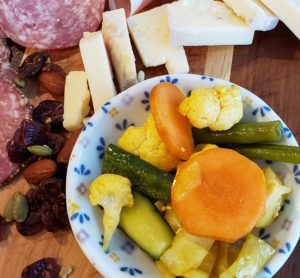
Simplified Achar
You don’t have to follow the exact measures. Just keep the ingredients pretty proportionate. You may also add one red chili if you want it spicy. I intend to garnish it with a sprinkling of freshly-roasted sesame seeds just before serving.
4 ounces carrots, sliced crosswise, about ¼ inch thick
4 ounces cucumber, cut in strips, seeds completely removed
6 ounces cauliflower, cut into small flowerettes
4 ounces cabbage, cut in short strips
4 ounces string beans, cut in one inch pieces
¼ cup roasted sesame seeds
2 tablespoons oil
Salt
8-10 tablespoons sugar
Distilled vinegar
Rempah
4 ounces onions, chopped
3 cloves garlic, sliced
3=4 slices galangal
1 tablespoon curry powder
Slice vegetables into approximately the same size. Carrots should be about ¼ inch thick. Leave them in separate piles as you will be brining them separately. Place each vegetable in plastic bags and add ½ teaspoon of salt in each bag. Toss to mix salt into vegetables and set aside overnight. This will draw out the water.
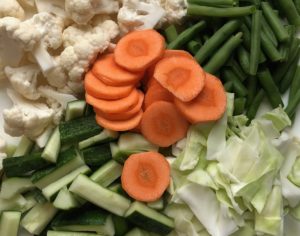
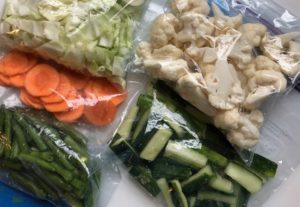
The vegetables are perfect if they can bend without breaking into half.
Carefully add hot water to each bag and then drain into a colander. At this point the vegetables may all be placed together. Leave to drain until vegetable is cool.
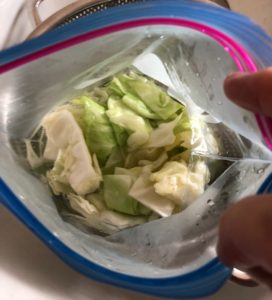
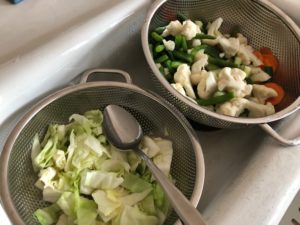
Meanwhile gather rempah ingredients together.
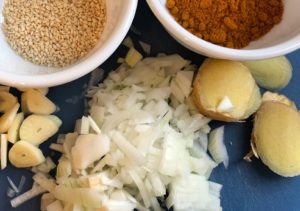
Dry vegetables well in kitchen towel.

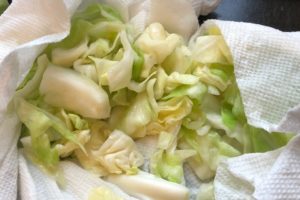
Heat a wok or frying pan, add oil and heat for a 1-2 minutes until oil is hot but not smoking. Add onions and fry quickly for 15 seconds. Add ginger, garlic and galangal and fry quickly. Lower heat to medium to prevent browning the aromatics. Fry until onion is tender and soft. Add curry. Fry with aromatics. Add 1-2 tablespoons of water and fry to combine until ingredients become a paste.
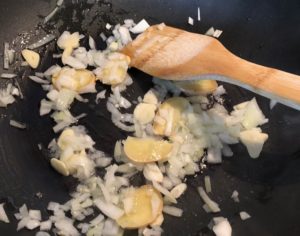

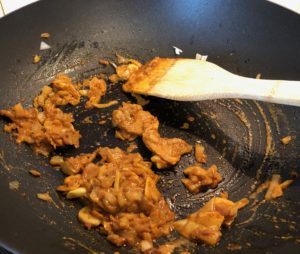
Remove pan from heat. Then add all the vegetables and mix quickly to combine. Add sesame seeds. Leave to cool.
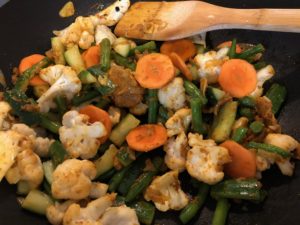
Meanwhile combine 1½ cups of vinegar and 8-10 tablespoons sugar in a measuring cup. Test taste to see if you like the level of sweetness and adjust to your taste.
Add vinegar to pan and stir to mix. Taste and adjust with sugar and salt. Place mixed vegetables in jars. Press vegetables tightly into the jar. Fill jar with the vinegar in pan. There should be enough solution covering the vegetables. Cover tightly with a lid. Leave on counter overnight.
Store in refrigerator.
